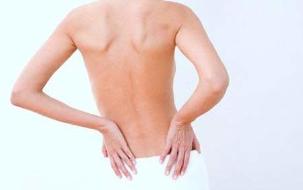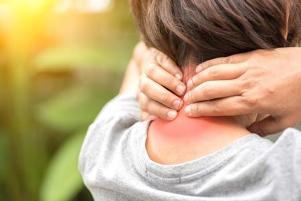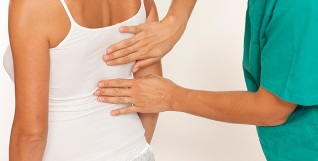
The spine performs the most important functions in the human body. From this article you will learn everything about what is osteochondrosis, what are the symptoms and treatment of this disease, what are the signs of pathology and causes of the disease.
What is osteochondrosis
Osteochondrosis is a disease in which the intervertebral discs and other tissues of the spine are affected. Dystrophic processes are caused within the spine. The vertebrae, as it were, compress, press these discs, which gradually leads to the apex of the nerve endings of the spinal cord.Important! If osteochondrosis is not treated, the pathology can cause disability.
About 80% of the world's population suffers from spinal pathologies. Osteochondrosis is most often diagnosed among people aged 15-30 years. Although the disease occurs in both men and women, a strong half of humanity is more difficult to tolerate this disease.
The disease begins to develop and appears in relatively adulthood, when a person leads an active life. Although osteochondrosis is possible in children, it occurs much less frequently than in adults.
Despite the fact that experts around the world have joined forces to eradicate the disease, new cases of osteochondrosis are registered every year. Whether problems arise greatly depends on the personal efforts of the individual.
Existing classification
There are many types of osteochondrosis, so different doctors may apply different classifications.
Depending on which part of the spine is affected, there are:
- cervical osteochondrosis;
- osteochondrosis of the thoracic spine;
- osteochondrosis of the lumbar spine;
- osteochondrosis of the sacral region.
Whatever kind of illness a person faces, the complications are always serious. Therefore, it is important to identify the disease as soon as possible and provide qualified first aid.
When a doctor makes a diagnosis, he notices at what stage the pathology is detected. With osteochondrosis, 3 stages are distinguished according to the X-ray examination figure and 4 stages according to symptomatic changes.
What happens during pathology
Almost all beads have a similar structure. They consist of a vertebral body and an arch. All the vertebrae, "folded" together, form a spinal canal. The discs are located between the vertebrae - jelly-like tendons that act as shock absorbers.
It is in the intervertebral discs with osteochondrosis that the pathological changes begin. The fibrous part gradually becomes more fragile. Under the pressure of the vertebrae, the nucleus pulposus seems to make a movement on its own and seeks a place where it is easier to do so.
In most cases, the disc comes out of the spinal canal. This leads to compression of the spinal cord and nerves located there. The result is pain and symptoms in the organs for which these nerves are responsible.
In response to pressure on the body, accelerated bone tissue separation processes are induced. As a result, the development of osteophytes begins - bone growths that cause a person major problems with osteochondrosis.
So with osteochondrosis of the cervical spine, the consequences can be sad, as the pathological process affects both the nervous and vascular systems simultaneously.
Causes of osteochondrosis
Since osteochondrosis is a dangerous enemy, it is important to understand what causes the onset of the disease. No matter where the disease is located, its causes are always similar.
The main reasons why osteochondrosis can develop are:
- premature aging of tissues in the intervertebral discs;
- continuous overload of the muscles supporting the spine;
- lack of reasonable stress on these muscle groups;
- uneven distribution of load between parts of the spine, which leads to imbalance and the development of pseudospondylolisthesis;
- presence of a genetic predisposition for the development of degenerative processes in cartilage tissues;
- the presence of autoimmune diseases, due to which self-antibodies disrupt the nutrition of the spine.
Undoubtedly, hormonal imbalance and poor diet can also affect spinal health. Some women first encountered symptoms of the disease during pregnancy when the workload increased.
Risk group
Acute osteochondrosis usually develops after exposure to negative factors. The following factors may cause symptoms:
- incorrect behavior;
- sedentary lifestyle;
- prolonged positioning in an uncomfortable position;
- lifting heavy weights;
- scoliosis;
- lack of a spinal muscular corset;
- lack of vitamins and minerals needed for bone and cartilage tissue regeneration;
- emotional experiences;
- severe infections;
- impact of unfavorable ecology;
- prolonged hypothermia;
- being injured;
- immediate changes in body position;
- power sports;
- wearing shoes with uncomfortable heels;
- mbipesha;
- metabolic disorders;
- rheumatism;
- congenital malformations.
As you can see, many factors can provoke the development of osteochondrosis. However, the sooner the first signs of the disease are detected and the diagnosis is made, the more chances there are for the pathology to be cured and the quality of life to be preserved.
Characteristics of the disease by stages
There are 4 stages of the disease and each has its own intensity of symptoms:
- with grade 1 disease, the patient experiences no general symptoms but may have only localized pain;
- with grade 2 osteochondrosis, the pain becomes stronger, the elongation of the discs develops and the subluxation of the vertebral bodies develops, static violations are observed;
- for grade 3 osteochondrosis, significant symptoms, including general ones, are characteristic and the lesion reaches the stage of development of intervertebral hernia;
- in 4 stages of pathology, disability occurs and any medication no longer brings relief.
Of course, if osteochondrosis is detected at an early stage, it is quite possible to stop the progression of the disease.
However, intervertebral osteochondrosis is divided depending on the damage to the vertebral body:
- there is no violation in stage 0;
- in the first stage the concerns are insignificant, sometimes there are internal vertebrae in the vertebrae;
- in stage 2, the changes on the disk are quite noticeable and pronounced, however, the outer surface is preserved;
- In stage 3, the disc is completely touched, squeezed in the spinal cord area or out.
If you experience minor symptoms, even lumbar spine instability, or discomfort in any other area, you should consult a specialist for advice.
Symptoms of osteochondrosis
As already noted, the intensity of symptoms depends on the degree of damage to the vertebral body and the location of the injury. Most patients report similar symptoms.
When the pathological process is localized in the cervical spine, the following symptoms are possible:
- blurred vision;
- ear overload;
- noise in the head;
- tinnitus;
- dizziness;
- headache;
- sleep apnea;
- hearing impairment;
- faint;
- weakness of the vocal cords;
- cramps in the neck;
- changes in blood pressure;
- numbness of the tongue;
- swelling of the neck;
- eye pain;
- insomnia;
- neck vasospasm;
- dental problems.

With spinal cord lesions in the chest region, the following phenomena occur:
- muscle spasm, resembling heart pain of a sharp, stabbing and sharp character;
- the patient has difficulty breathing;
- pain and burning in the sternum;
- has a lump in the throat;
- cough and possible nausea;
- abdominal pain occurs, especially during inhalation and deep breathing;
- has great weakness in hands and feet;
- anxiety increases with a change in body position.
For sacral or lumbar spine problems, the following complaints occur:
- radiating back pain in the legs;
- freezing of the lower extremities at normal body temperature;
- numbness in the legs;
- constant tension in the leg muscles;
- varicose veins;
- impotence;
- pale skin;
- dismenorrea.
As osteochondrosis of the spine progresses, several vertebrae may join together. Then the symptomatology gradually fades, but reappears during the spring-autumn deterioration.
If the vagus nerve is tight, digestion, palpitations, and bladder and bladder problems may occur.
Syndromes in osteochondrosis
doctors It is customary for doctors to divide the symptoms into groups, syndromes. With intercostal osteochondrosis, there are:
- vertebral syndrome;
- vertebral artery syndrome;
- cardiac or scapular rib syndrome;
- radical.
It is worth taking a closer look at each of the syndromes.
Vertebral
With vertebral syndrome, the following picture is seen:
- movement
- is damaged and neck soreness appears;
- changes in the state of the beads are visible on the x-ray;
- the patient cannot turn his head sideways without pain.
Important! When diagnosing, the physician should differentiate between myositis and vertebral syndrome, as the clinical picture is similar but the treatment methods are different.
Vertebral artery
With this osteochondrosis syndrome, the following manifestations are observed:
- nausea, vomiting;
- pressure waves;
- dizziness;
- migraine;
- flies in the eye;
- drowsiness;
- lethargy;
- fatigue;
- violation of emotional stability.
The physician must differentiate this syndrome from atherosclerotic changes in vessels and tumor processes.
Kardiak
This syndrome is characterized by:
- djegia;
- chest pain;
- gulçim;
- fatigue;
- takikardi.
When visiting a hospital, an ECG and angiography should be done, which confirms the absence of atherosclerosis.
Radical
Pathological signs depend on what the roots have undergone changes. In general, this group of symptoms includes:
- discomfort in the occupied area;
- discomfort in the tongue;
- Difficulty chewing food;
- pain when swallowing;
- discomfort in the shoulder area;
- Difficulty performing hand movements;
- do not possess 4 and 5 fingers.
Since most often some parts of the spine are involved in the pathological process in osteochondrosis, whole groups of symptoms arise.

Diagnostics
When the symptoms of osteochondrosis appear, as a rule, tests are not taken.
Some of the following tests are sufficient to make a diagnosis:
- x-ray;
- computed tomography;
- magnetic resonance.
Although a conventional X-ray examination allows a diagnosis, CT and MRI are used to more effectively select drugs and determine the degree of spinal cord injury.
Treatment of osteochondrosis
Both during an exacerbation and during planned therapy, treatment should be comprehensive. Applies to:
- drug treatment;
- manual therapy;
- Exercise therapy for osteochondrosis.
The most common treatment is at home. The main thing is that the patient strictly adheres to the doctor's prescription. When a patient needs injections, a day hospital may be recommended.
Features of drug treatment
Medication treatment involves the use of several groups of drugs at the same time. Non-steroidal anti-inflammatory drugs have been prescribed.
NSAIDs are initially described as oils. As the disease progresses, tablets, injections or another form of antispasmodic may be recommended. Almost all non-steroidal anti-inflammatory drugs have a pronounced analgesic effect.
In order for your back to relax, you need to relieve muscle spasm. For these purposes, muscle relaxants are used.
If treatment begins in the early stages of the disease, when the cartilage tissue has not yet been destroyed, it makes sense to take chondroprotectors.
Important! In order for all of these drugs to have any effect, they must be taken systematically, for at least six months.
B vitamin complexes can have a positive effect on recovery.
The following medications may also be prescribed:
- to dilate blood vessels and improve nutrition;
- to fight vertigo;
- day gel to improve blood circulation.
Compresses, mustard plasters and special anesthetic plasters with a medicinal composition are placed on the affected areas.
Perform manual therapy
Although massaging the neck and other affected areas is believed to be a popular method, this judgment is wrong. Such procedures can be performed only after a doctor's prescription and careful training. Wrong actions can cause even more harm.
You can massage with honey, or any other treated oil. The following techniques are used:
- light strokes are performed with the fingertips, starting from the head to the upper back;
- friction in progress;
- squeezing to involve deep layers of tissue;
- kneading.
Cup massage is effective. Self-massage can be performed. Highly it is highly undesirable to use massager without consulting your doctor, as a measured impact can damage already fragile discs.
The value of exercise therapy in osteochondrosisTo get rid of the symptoms of osteochondrosis, it is important to regularly perform a series of exercises for the back. There are now many popular techniques for forming corset lumbar and cervical. Let us consider only the most effective ones and briefly discuss their essence.
Physiotherapy's neck gymnastics helps improve blood circulation, relieve pain and restore freedom of movement. It does not give a quick effect, the result is only after long-term therapy. In addition to exercise, it is important to consider the treatment prescribed and follow the diet. All exercises are performed at a very slow pace, during the process, the muscles are stretched properly.
Therapeutic exercises for the neck of another doctor for osteochondrosis is useful not only for people with osteochondrosis, but also for many other problems. The complex more closely resembles neck exercises, and classes can also be conducted at lunchtime. To achieve results and strengthen muscles, you should exercise regularly and only after your doctor's appointment.
General recommendations in the treatment of osteochondrosis
Since patients with osteochondrosis need careful periodic heating, a visit to the spa will be beneficial for such a patient. It is only important to consider the stage of the disease and the presence of other pathologies. Before such a procedure, you should consult a doctor.
To strengthen muscle corsets, you can use push-ups, fitness and Pilates with a trainer. It is necessary to visit the pool regularly. Each swimming session should not be shorter than 20 minutes, otherwise it will have no effect.
Treatment with folk remedies is allowed, but only after agreement with the attending physician and as an adjunct therapy. Physiotherapy, including electrophoresis, can be performed as directed by a physician.
Prevention
Even if spinal problems seem insignificant, or the patient is still a child, it is still important to actively engage in the prevention of osteochondrosis.
It is important to observe the following best practices:
- use orthopedic sleeping pillows;
- leads an active lifestyle;
- set aside time for sports, especially swimming;
- warm up several times a day;
- be careful when doing physically demanding work;
- give up bad habits.
Diet is important, as some foods increase the risk of disease, namely:
- salting;
- smoked meats;
- spices; sweets
- ;
- fatty and fried foods.
It is important to limit soda and coffee, and it is better to give preference to tea and soups. Proper nutrition will help protect the body from damage to bone and cartilage tissue.
Since the process can be stopped and even returned to the initial stages of osteochondrosis, it is necessary to immediately consult a doctor and undergo an examination when the first symptoms appear. This is the only way to maintain physical activity for many years!

























